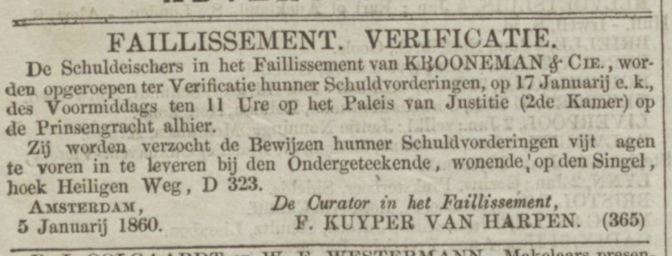If someone is unable to meet his financial obligations, the court can be asked to declare him bankrupt. The court appoints a curator who inventories the debts and assets of the bankrupt person, who the creditors are, and how they can best be paid. When everything is settled, which could take years, the bankruptcy is ended.
Bankruptcy files
Records are created of all the actions that happen after somebody is declared bankrupt. Together, these form a bankruptcy files. These files are part of the records of the court of first appeal [“rechtbank van eerste aanleg”] (1811-1838) and district courts [“arrondissementsrechtbank”] (1838-1989).
Contents of a bankruptcy file
The main contents of a bankruptcy file are:
- Requests with grounds upon which the court is asked to declare a person bankrupt.
- The verdict whereby the court determines somebody has ceased to pay and is declared to be bankrupt. This verdict includes the appointment of a curator.
- Protocol of the verification meeting during which the creditors and the debts they are owed are determined. This protocol may contain:
- A list of acknowledged debts, with names and amounts
- A report of the assets, which shows what the bankrupt person owes and what that is worth
- An inventory of the assets
- A report by the curator showing the reasons for the bankruptcy.
- Records about a possible agreement with creditors.
- Final accounts, detailing the claims of each creditor and what they received. These accounts may include the names of employees who had claims.
Bankruptcy register
Since 1896, every district court was required to keep a register, detailing the progress of each bankruptcy. This register often has a contemporary inde. The bankruptcy is filed in the court in the district where the person lives or where the company is located.
How to find bankruptcy records
Newspapers are a great place to find out if your ancestor ever went bankrupt. Bankruptcies were announced in newspapers by the court. Curators often posted ads calling creditors. Searching newspapers at Delpher may show you whether your ancestor was ever involved in a bankruptcy (“faillissement”).

Curator calling all creditors, 1860
The court records are usually kept in the regional historical center in the capital of the province. The Zeeuws Archief has an index of these records via Zeeuwen Gezocht. The original records can be consulted in the reading rooms. Some of these archives provide scanning-on-demand.

